
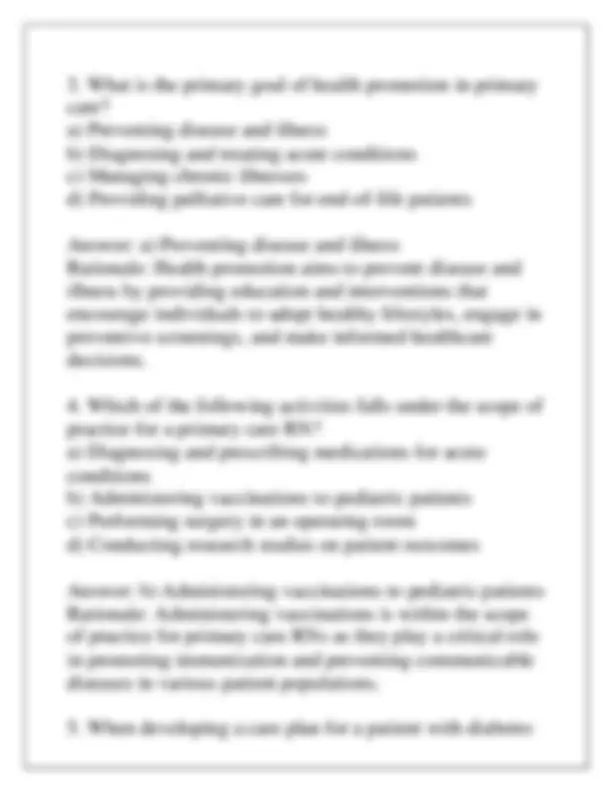
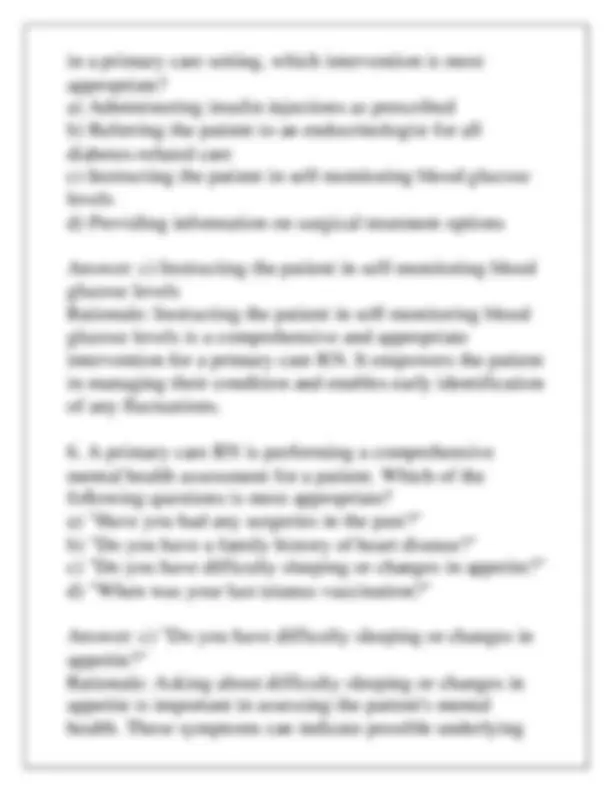
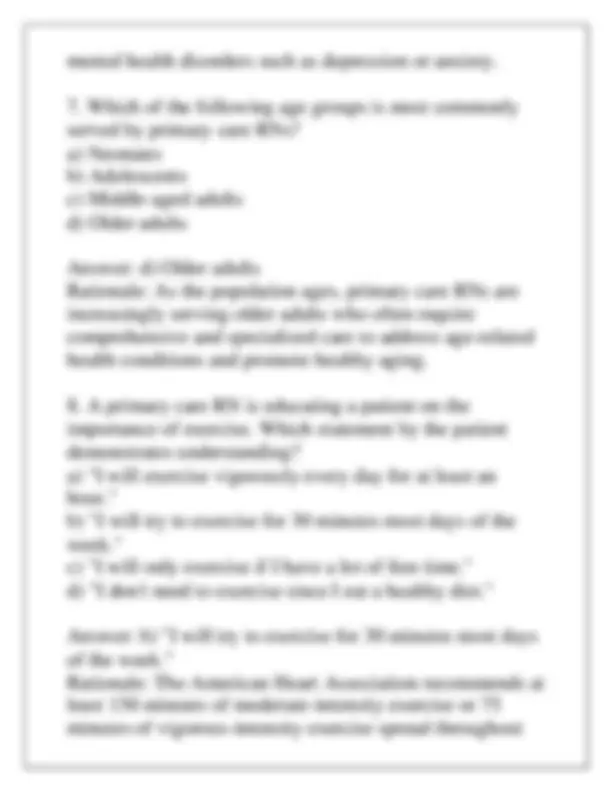
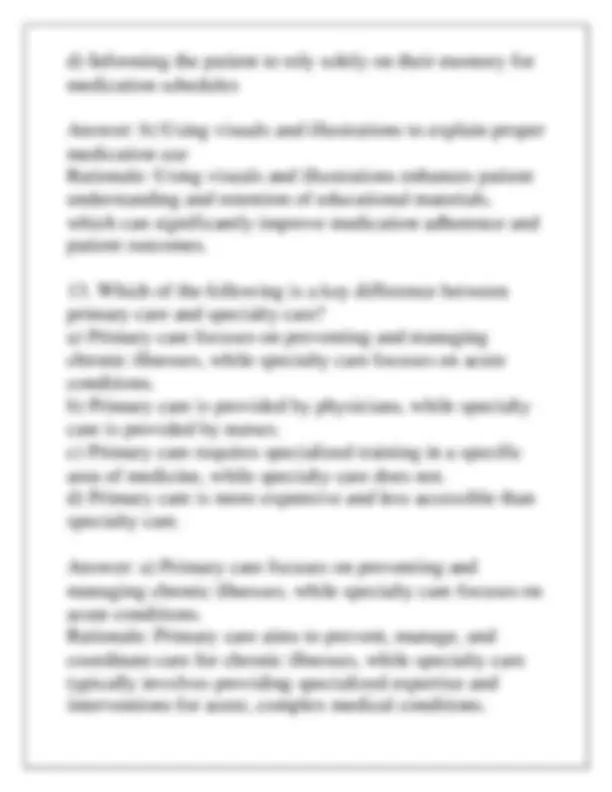
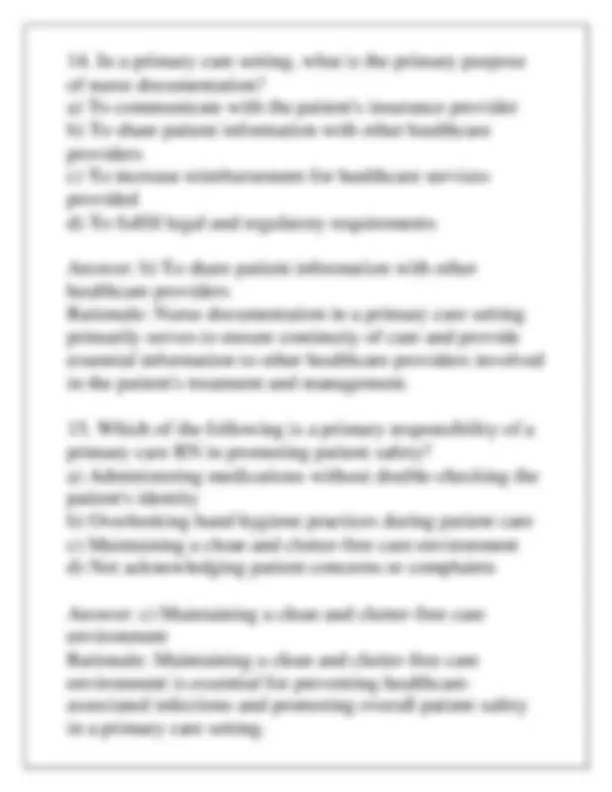
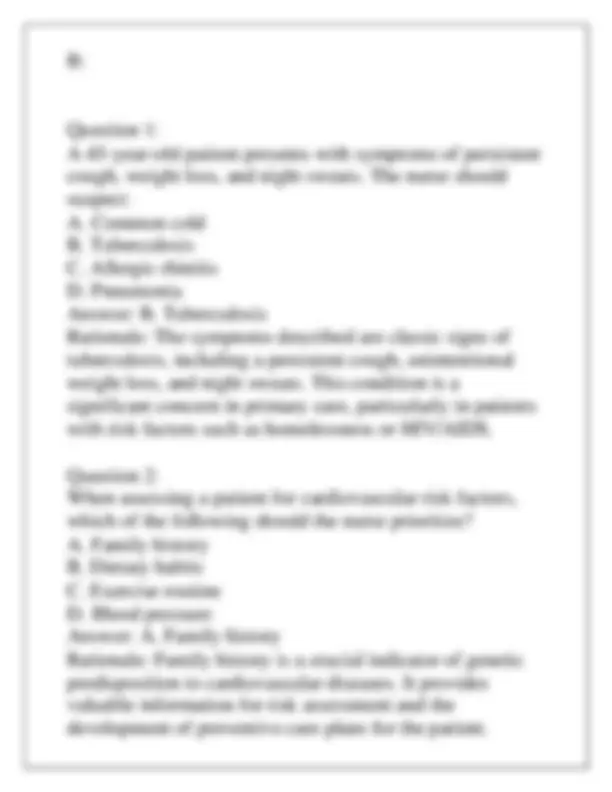
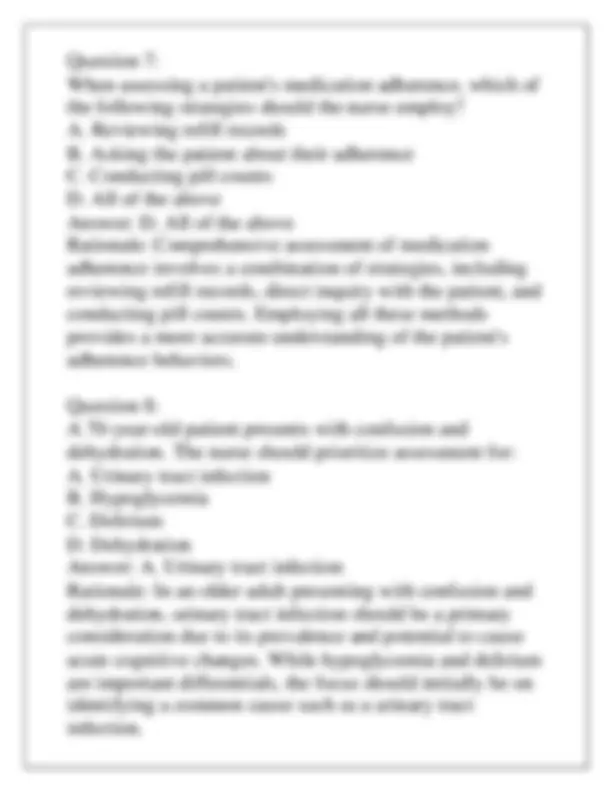
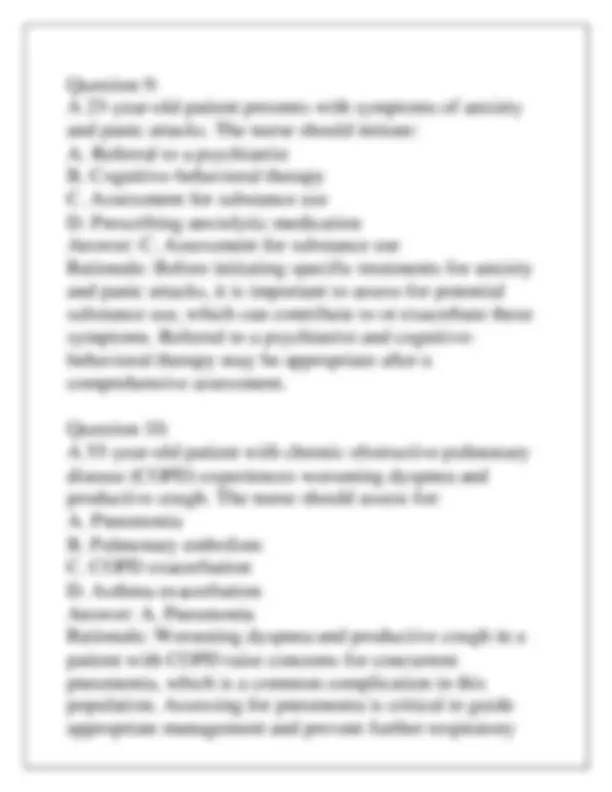
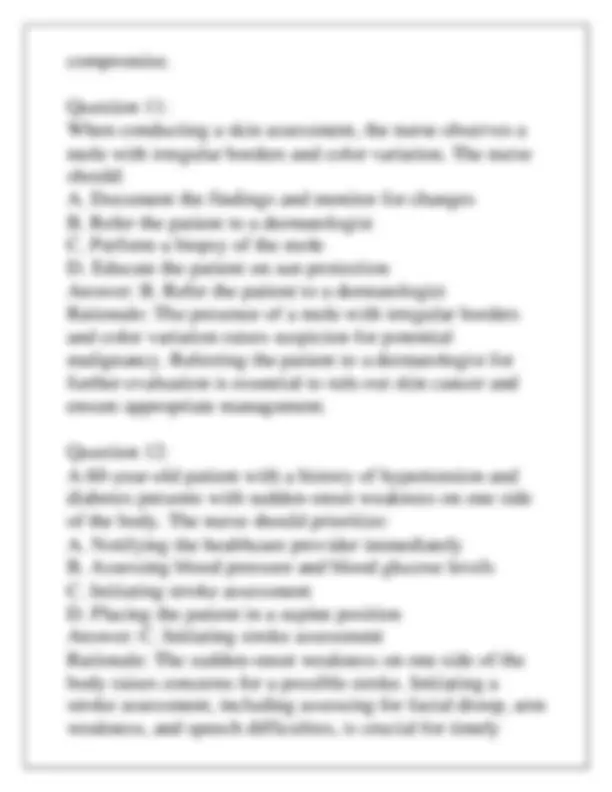
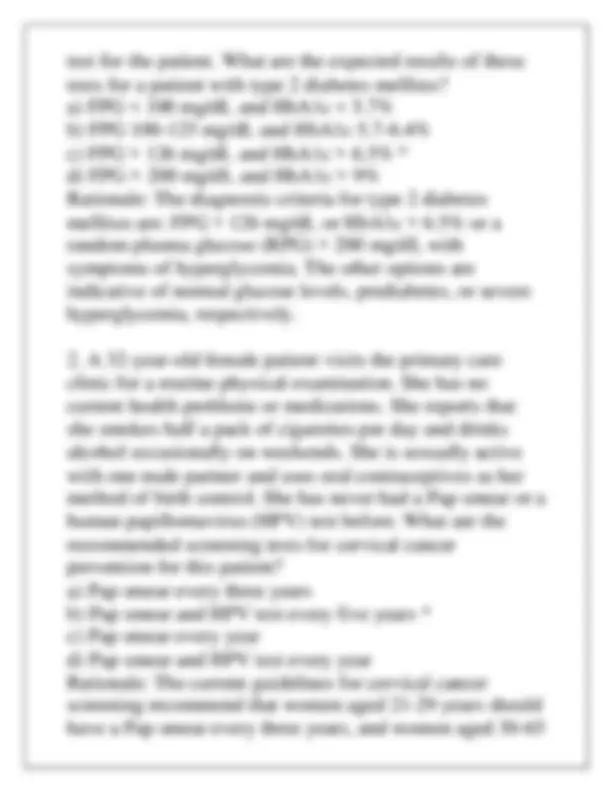
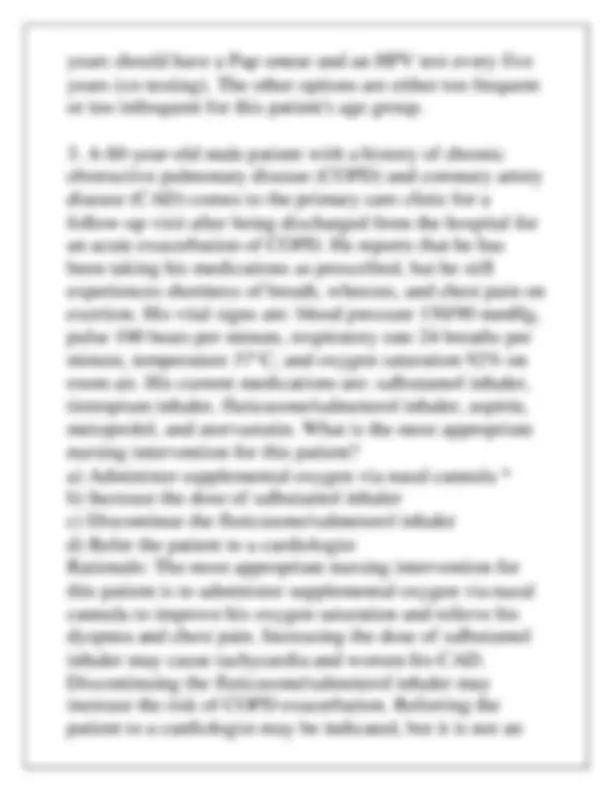
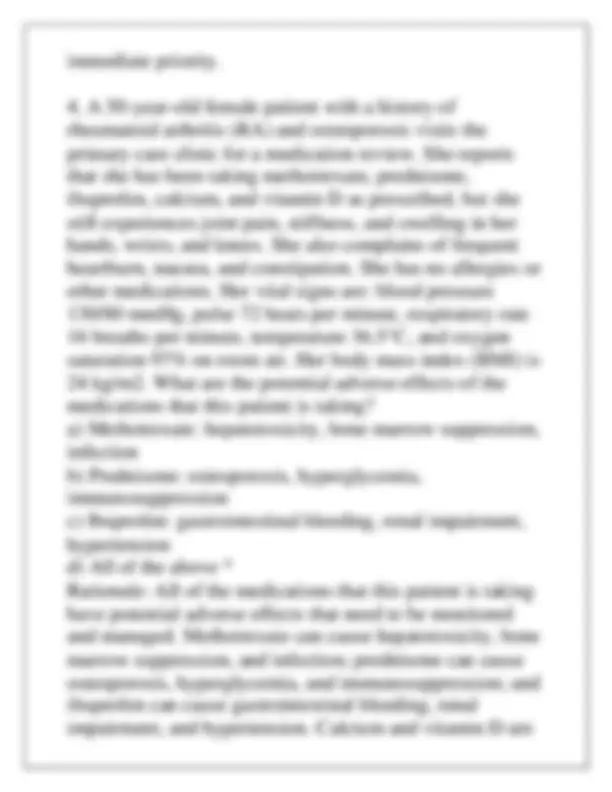
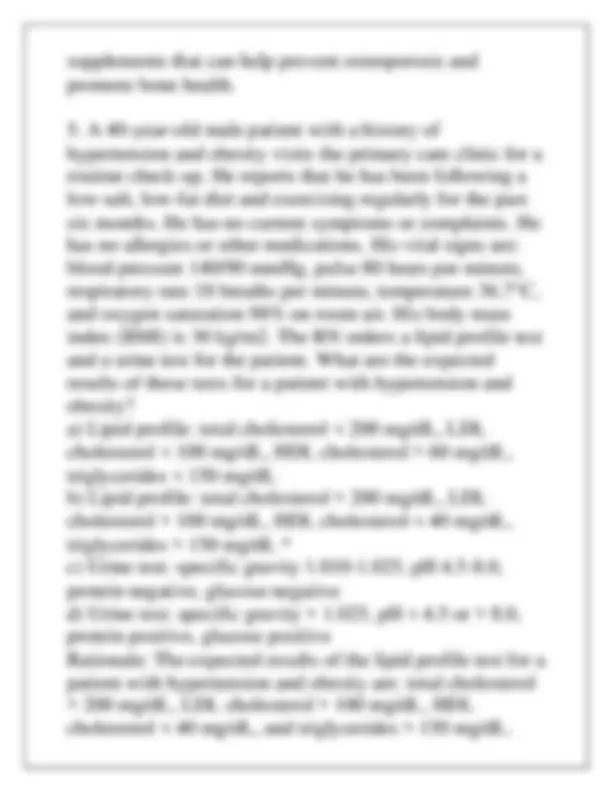
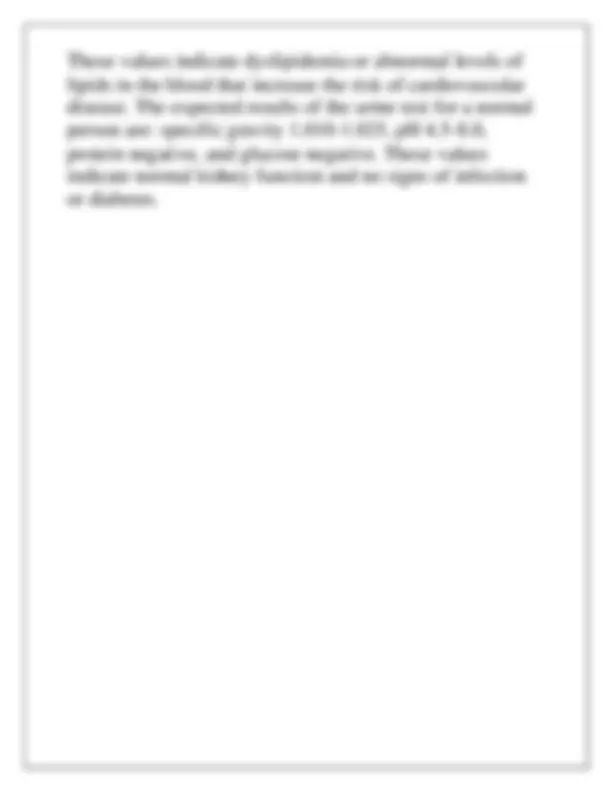


Study with the several resources on Docsity

Earn points by helping other students or get them with a premium plan


Prepare for your exams
Study with the several resources on Docsity

Earn points to download
Earn points by helping other students or get them with a premium plan
Community
Ask the community for help and clear up your study doubts
Discover the best universities in your country according to Docsity users
Free resources
Download our free guides on studying techniques, anxiety management strategies, and thesis advice from Docsity tutors
NRSADVN 3117 RN PRACTICE IN PRIMARY CARE EXAM Q & A 2024NRSADVN 3117 RN PRACTICE IN PRIMARY CARE EXAM Q & A 2024NRSADVN 3117 RN PRACTICE IN PRIMARY CARE EXAM Q & A 2024
Typology: Exams
1 / 22

This page cannot be seen from the preview
Don't miss anything!















in a primary care setting, which intervention is most appropriate? a) Administering insulin injections as prescribed b) Referring the patient to an endocrinologist for all diabetes-related care c) Instructing the patient in self-monitoring blood glucose levels d) Providing information on surgical treatment options Answer: c) Instructing the patient in self-monitoring blood glucose levels Rationale: Instructing the patient in self-monitoring blood glucose levels is a comprehensive and appropriate intervention for a primary care RN. It empowers the patient in managing their condition and enables early identification of any fluctuations.
mental health disorders such as depression or anxiety.
Rationale: Home visits provide primary care RNs with a unique opportunity to assess patients in their own environment, helping to gain insight into their living conditions, social support systems, and potential barriers to optimal healthcare.
d) Informing the patient to rely solely on their memory for medication schedules Answer: b) Using visuals and illustrations to explain proper medication use Rationale: Using visuals and illustrations enhances patient understanding and retention of educational materials, which can significantly improve medication adherence and patient outcomes.
Question 1: A 45-year-old patient presents with symptoms of persistent cough, weight loss, and night sweats. The nurse should suspect: A. Common cold B. Tuberculosis C. Allergic rhinitis D. Pneumonia Answer: B. Tuberculosis Rationale: The symptoms described are classic signs of tuberculosis, including a persistent cough, unintentional weight loss, and night sweats. This condition is a significant concern in primary care, particularly in patients with risk factors such as homelessness or HIV/AIDS. Question 2: When assessing a patient for cardiovascular risk factors, which of the following should the nurse prioritize? A. Family history B. Dietary habits C. Exercise routine D. Blood pressure Answer: A. Family history Rationale: Family history is a crucial indicator of genetic predisposition to cardiovascular diseases. It provides valuable information for risk assessment and the development of preventive care plans for the patient.
Question 3: A 65-year-old patient with diabetes presents with a foot ulcer. The nurse identifies signs of infection and should prioritize: A. Initiating antibiotic therapy B. Assessing blood glucose levels C. Referring to a podiatrist D. Educating the patient on foot care Answer: A. Initiating antibiotic therapy Rationale: In the presence of an infected foot ulcer, prompt initiation of antibiotic therapy is essential to prevent further complications, including sepsis. Assessing blood glucose levels and patient education are important but should follow the immediate management of the infection. Question 4: During a routine well-child visit, the nurse observes a 4- year-old displaying developmental delays and difficulty with speech. The nurse should: A. Schedule a hearing test B. Refer the child to a speech therapist C. Educate the parents on developmental milestones D. Perform a comprehensive neurological assessment Answer: B. Refer the child to a speech therapist Rationale: Speech delays in a 4-year-old should prompt a referral to a speech therapist for further evaluation and intervention. While educating the parents on developmental milestones is important, the priority is to address the specific concern identified during the visit.
Question 7: When assessing a patient's medication adherence, which of the following strategies should the nurse employ? A. Reviewing refill records B. Asking the patient about their adherence C. Conducting pill counts D. All of the above Answer: D. All of the above Rationale: Comprehensive assessment of medication adherence involves a combination of strategies, including reviewing refill records, direct inquiry with the patient, and conducting pill counts. Employing all these methods provides a more accurate understanding of the patient's adherence behaviors. Question 8: A 70-year-old patient presents with confusion and dehydration. The nurse should prioritize assessment for: A. Urinary tract infection B. Hypoglycemia C. Delirium D. Dehydration Answer: A. Urinary tract infection Rationale: In an older adult presenting with confusion and dehydration, urinary tract infection should be a primary consideration due to its prevalence and potential to cause acute cognitive changes. While hypoglycemia and delirium are important differentials, the focus should initially be on identifying a common cause such as a urinary tract infection.
Question 9: A 25-year-old patient presents with symptoms of anxiety and panic attacks. The nurse should initiate: A. Referral to a psychiatrist B. Cognitive-behavioral therapy C. Assessment for substance use D. Prescribing anxiolytic medication Answer: C. Assessment for substance use Rationale: Before initiating specific treatments for anxiety and panic attacks, it is important to assess for potential substance use, which can contribute to or exacerbate these symptoms. Referral to a psychiatrist and cognitive- behavioral therapy may be appropriate after a comprehensive assessment. Question 10: A 55-year-old patient with chronic obstructive pulmonary disease (COPD) experiences worsening dyspnea and productive cough. The nurse should assess for: A. Pneumonia B. Pulmonary embolism C. COPD exacerbation D. Asthma exacerbation Answer: A. Pneumonia Rationale: Worsening dyspnea and productive cough in a patient with COPD raise concerns for concurrent pneumonia, which is a common complication in this population. Assessing for pneumonia is critical to guide appropriate management and prevent further respiratory
intervention and management. Question 13: During a prenatal visit, a pregnant patient reports persistent vomiting and weight loss. The nurse should consider: A. Hyperemesis gravidarum B. Gestational diabetes C. Iron-deficiency anemia D. Gastroenteritis Answer: A. Hyperemesis gravidarum Rationale: Persistent vomiting and weight loss in pregnancy are indicative of hyperemesis gravidarum, a severe form of morning sickness. Considering this diagnosis is important for appropriate management and support for the pregnant patient. Question 14: A 40-year-old patient presents with symptoms of polyuria, polydipsia, and unexplained weight loss. The nurse should assess for: A. Type 1 diabetes B. Type 2 diabetes C. Diabetes insipidus D. Hyperthyroidism Answer: A. Type 1 diabetes Rationale: The classic symptoms described are consistent with type 1 diabetes, particularly in the absence of risk factors for type 2 diabetes. Assessing for type 1 diabetes is crucial for timely diagnosis and management.
Question 15: A 20-year-old patient presents with a history of unprotected sexual intercourse and requests emergency contraception. The nurse should: A. Provide emergency contraception without further assessment B. Assess for pregnancy and discuss contraceptive options C. Refer the patient to a gynecologist D. Educate the patient on safe sex practices Answer: B. Assess for pregnancy and discuss contraceptive options Rationale: Before providing emergency contraception, it is important to assess for pregnancy and discuss long-term contraceptive options with the patient. This approach ensures comprehensive care for the patient's reproductive health needs. C:
years should have a Pap smear and an HPV test every five years (co-testing). The other options are either too frequent or too infrequent for this patient's age group.
immediate priority.